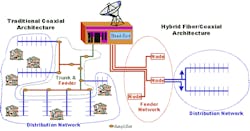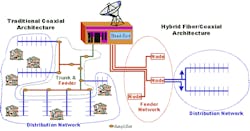MaxLinear's Virtual Fiber SoC fits with Europe's GiaX to drive 10G Ethernet coax cable overlay network
MaxLinear (NYSE: MXL), a provider of radio frequency (RF) and mixed-signal integrated circuits for driving connected home, wired and wireless infrastructure, as well as industrial and multimarket applications, announced that GiaX GmbH has selected its MxL85110 broadband modem system on chip (SoC) for its HelEOS network system, which delivers 10 Gbps symmetrical throughput over coaxial cable infrastructure. Delivering 20 Gbps throughput, Maxlinear says its MxL85110 silicon provides "a flexible Virtual Fiber solution that meets the evolving demands of cable backhaul networks, supporting both distributed access architectures (DAA) and Full Duplex DOCSIS 3.1 (FDX) use cases in products like the GiaX HelEOS."
The GiaX HelEOS provides the option for cable multiple-system operators (MSOs) to reuse existing coaxial infrastructure, provide high throughput, and be deployable on short notice on an as-needed basis. A tier-1 cable operator is now evaluating the HelEOS solution to provide a 10G Ethernet overlay network as backhaul technology for remote PHY or remote MAC PHY devices, utilizing the existing coaxial network. The GiaX HelEOS solution provides cable operators with a virtual node split capability, retaining the existing coaxial infrastructure while also enabling fiber deep, DAA and FDX networks.
As noted by the companies, "With the ever-increasing hunger for bandwidth from their customers, cable operators are looking at new technologies for cable access networks to offer higher and symmetrical bandwidth services. Both DAA and FDX are key enablers for these requirements, in combination with re-segmentation of the service groups (node splits). Implementing these changes requires parts of the coaxial network to be replaced with fiber cable, implementing so called 'fiber deep' network architectures. While fiber deep architectures provide lower subscriber counts per service-group and hence make more bandwidth available for those subscribers, there are also several drawbacks. The cost of equipment and labor can quickly add up, particularly with underground networks. Further, the time, cost and uncertainty around securing necessary approvals can be equally burdensome."
GiaX notes that for the Ethernet data transmission in its HeIEOS system, unused frequency spectrum above frequencies used for DOCSIS 3.x and DVB-C or MPEG is utilized. The HelEOS platform can currently transport up to 10Gbps in both upstream and downstream directions. Depending on the cable type and frequencies used, transmission can be accomplished over several hundred meters. The company adds that "DAA and FDX are not the only use cases for the HelEOS solution -- fiber to the business, distributed PON and mobile backhaul can all take advantage of the HelEOS solution, allowing for a fast time to market and reduction in CAPEX spending compared to traditional fiber deployments."
The HelEOS system relies on MaxLinear’s MxL85110 chipset, which provides up to 20 Gbps (10 Gbps downstream and 10 Gbps upstream) Ethernet capacity. The MxL85110 offers ultra-low latency of five microseconds per node and adaptive code modulation ranging from BPSK to 1024 QAM. The device can be programmed for flexible bandwidth from 25MHz to 2GHz, with independent asymmetric transmit and receive configuration. It also delivers the highest spectral and payload efficiency for efficient utilization of cable bandwidth with no MAC-layer overhead. Additional features used in the HelEOS solution include carrier-grade synchronous Ethernet and IEEE 1588v2 synchronization and an integrated management channel.
Image:sumlocable.com
“I have been impressed at the innovation used by GiaX to bring this system to market. Leveraging the company’s close service providers relationships, it has addressed a capacity constraint within the existing HFC networks,” comments Brendan Walsh, vice president of Maxlinear's wireless group. “While its existing system can support data rates up to 10 Gbps, leveraging our technology, throughput of up to 25 Gbps will be realizable.”
Simply put, the HelEOS 10G Ethernet overlay system comprises a modem and switch technology that combines point-to-point Ethernet connections over existing coaxial cables into an Ethernet overlay system on the HFC network. This Ethernet overlay system offers fiber-like speeds as well as MEF management functions.
“Deploying fiber can be expensive compared to coaxial cable for a portion of the backhaul links in an operator’s network,” concludes Jörg Hellwig, CEO and company founder of GiaX. Many urban communities require all cabling to be hidden or buried. In these areas, labor costs to deploy new network infrastructure can be prohibitive, creating a large incentive for reuse of the existing coaxial cable. By using the MaxLinear’s MxL85110 Virtual Fiber technology, we have enabled the HelEOS solution to meet our customer requirements for deployment of DAA architectures, saving them 2.5 billion Euros in over 4 years in Germany alone, while having the flexibility to adapt to new requirements in the future such as FDX.”

